
By Angelo Randaci, Earth’s Ally Horticulturist
Angelo’s passion for plants has led him to explore many areas of horticulture including research, grounds management, technical training, design and nursery management.
Across the country, homes, offices, shops and restaurants are adorned with flowering plants adding color and charm throughout the holiday season. It’s delightful to have a house filled with the fragrance of a rosemary topiary or brightened by the ruby red color of poinsettias or graced by the delicate porcelain flowers of the Christmas cactus. Although the blooms may fade with the close of the holiday season, with the proper care they can remain our companions through the winter months to reemerge next holiday season by growing them on through the summer months. This is a tradition our family started long ago and continues to enjoy year after year. The poinsettias gracing the front entrance of our home in Sarasota have been with us now for three seasons. We follow certain growing and re-blooming techniques that I will share with you here, so you too can keep your holiday plants for years to come.
Before and Aftercare of Christmas Plants
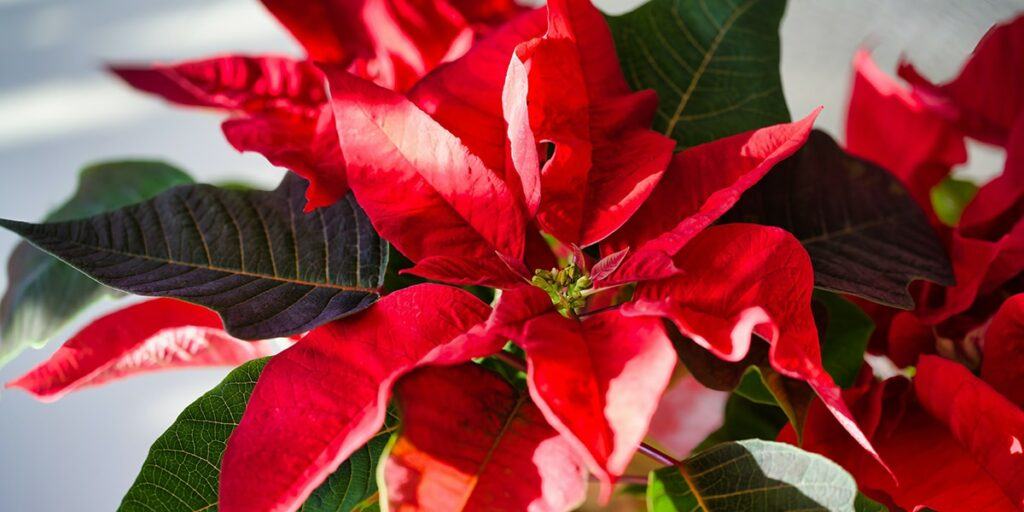
Poinsettia (Euphorbia pulcherrima)
Poinsettias are perennials in mild climates, becoming large, leggy shrubs in their native home. They are sometimes thought of as poinsettia trees when they grow large. Color is provided by the attractive bracts that surround tiny flowers. Many people think the bracts are the poinsettia flower, but they’re modified leaves. One of the lovely features of poinsettias is their long life span. In their native habitat, they bloom as the days get shorter and then fade as the days get longer. Purchased poinsettias can maintain good color for 3-4 months well after the holiday season.
Choosing your poinsettia:
Here are a few things to look for when choosing your plant:
- Avoid plants sprayed with glitter as this may affect plant health. Foliage should be dark green unless it is a variegated variety.
- Avoid plants with wilted or yellow leaves.
- Inspect plants by checking the undersides of the leaves for insect pests.
- Look for tight yellow, white, or green buds for flower buds. Avoid flowers showing yellow pollen because they will not provide the longest show of color.
- Leave wrappers on the plant while transporting home to avoid cold damage but remove wrappers and sleeves, especially plants enclosed in cellophane wrappers once you get them home. They can cause premature aging due to excess buildup of ethylene and moisture.
- Do not leave your plant in the car unattended for any length of time because temperatures below 50° F can damage them.
- Once you get home, move your plant to a warm sunny location receiving at least 6 hours of bright indirect sunlight free of drafts.
- Do not place your plants close to windows where they may get too much of a chill at night. Avoid hot spots like the tops of appliances or near fireplaces. Day temperatures of 65-70° F are ideal but temperatures below 60° F may cause leaf drop.
Water: Make sure the plant’s pot has drainage holes. If not, repot your plant in a similar-sized container with drainage holes. Watering frequency depends on the conditions in your home. Check the soil surface of the plant and when it feels dry to the touch, water thoroughly with tepid water. Water regularly to keep the soil lightly moist but not soggy. You may only need to water your plant once every few weeks. Yellow leaves are an indication that your plant is receiving too much water. Water until you see water draining out of the pot and never let the plant sit in standing water.
Poinsettias react to shortening day length. This change in light exposure initiates flower bud production along with colorful bracts. Your new plant has already gone through several weeks of darkness in the greenhouse to produce its beautifully colored bracts and now the bright light of its new home will initiate further growth and color.
Aftercare: In the wild, poinsettias go through a dormancy period to survive yearly drought conditions in their native tropical dry forests of North and Central America. Likewise, in your home at some point, your plant will begin to drop its leaves and bracts. This is normal because it is going through its natural dormancy period.
Gradually reduce watering frequency when about half of the leaves have fallen off. Allow the soil to dry out gradually. Keep your plant under normal household conditions where it will receive bright, indirect light. Water sparingly, only enough to prevent stems from shriveling. Newer varieties of poinsettias are bred for lasting flowers that may last well into March. In this case, dormancy will be short before new growth begins.
Once your plant initiates new growth, repot in fresh well-draining potting soil. Choose a pot that is roughly one size larger. Give it a complete watering and place it in a bright area. Fertilize with a house plant fertilizer around the first of March according to label recommendations. You can place them outdoors in a bright partially shaded area when nighttime temperatures remain above 60° F.
Commercial growers treat their poinsettias for Christmas with a growth regulator to maintain compact, bushy plants. Though you will not achieve the same look as commercially grown plants, you can create bushy plants by pruning old stems in late spring. Cut stems back to four or six inches in height leaving one to three leaves on each stem. Pruning will produce new compact growth. As the day length becomes shorter in early fall, your plant will begin producing colorful bracts.
Fall: Coloring up of the bracts involves your plant receiving approximately 10 weeks of 13-14 hours of complete darkness and 6 hours of bright indirect sunlight. Begin this process sometime between mid-September and early October. In the wild, poinsettias receive complete darkness naturally at nighttime but plants in the home must be in a room with complete darkness for 13-14 hours. Once your plant has beautifully colored bracts (around early December), it is ready to be moved among your other festive holiday décor.
If you live in hardiness zones 9-11 and practice proper poinsettia care, you can grow your plants outdoors year-round.
Toxicity: Poinsettias emit a milky sap that oozes from the leaves and stems when broken. This milky sap may irritate people with a latex allergy or sensitive skin.
Poinsettias are considered mildly toxic to pets and people. Most people would have to eat five hundred leaves to reach even a potentially toxic dose. Some people are more sensitive and may experience nausea, vomiting or diarrhea if accidentally ingested. To date, there are no confirmed or documented cases of anyone dying or becoming gravely ill but be sure to wear gloves when handling plant parts and especially when pruning. The ASPCA lists this plant as poisonous to dogs and cats and that it is irritating to the mouth and stomach, sometimes causing vomiting.
Insect Pests: The number one insect pest problem is whiteflies. They, and other pests including mealybugs, thrips, and spider mites, can be prevented with treatments of Earth’s Ally 3-in-1 Plant Spray.
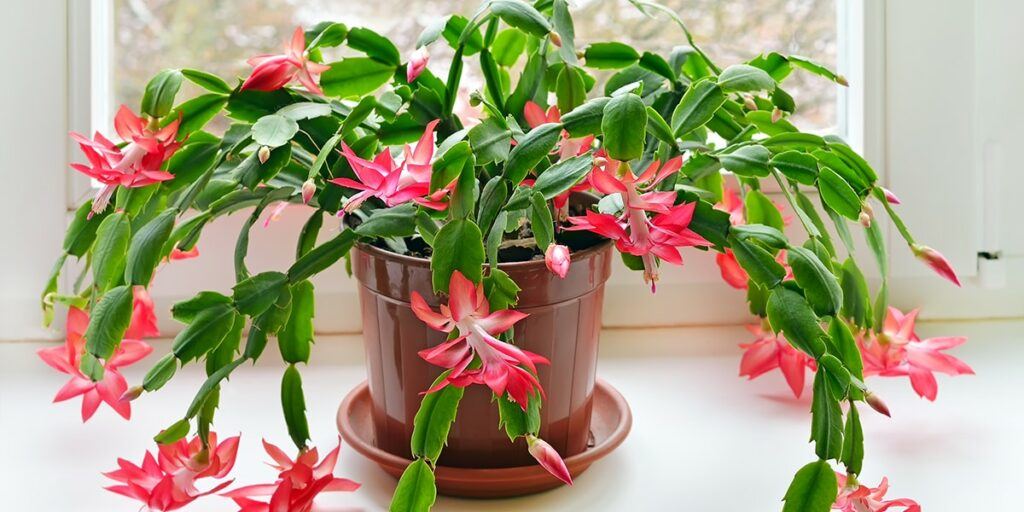
Christmas Cactus (Schlumbergera bridgesii)
The Christmas cactus plant is not a true desert cactus but is classified as a tropical cactus originating from Brazil’s shady, humid rain forests. In their native land, they grow as epiphytes on trees, shrubs, or among rocks in shade. Although we cannot completely replicate these conditions, providing the correct amount of water, light, food, and rest will assure success through the holiday season.
Watering: Because Christmas cactus is considered a tropical cactus and not a desert cactus, your plant will not tolerate completely dry soil. Water when the top inch of soil feels dry to the touch. Less water is better than too much water. If your plant is outdoors in a dry climate, you may need to water every 2-3 days. If in a humid, cool, or indoor environment watering once a week may be sufficient. As a rule, water less frequently during the fall and winter months to promote blooming.
Aftercare: Your Christmas cactus should bloom around February-March. After it’s finished, water sparingly for six weeks to allow the plant to rest. Water just enough to keep stems from shriveling.
In April-June the dormancy period will be over and new growth will appear. Begin your watering cycle again, adding water only when the top one inch or so of soil is dry to the touch. Check the roots of your container to be sure your plant is not pot bound and if so repot or top-dress your existing pot with fresh potting mix. Your potting mix must be well-draining. A succulent potting mix works well for repotting. When actively growing, apply a houseplant fertilizer at half the recommended rate monthly. You can prune your plant in late spring to encourage branching.
Move your plant outdoors in summer in a bright well-lit but partially shaded area. Avoid afternoon full sun. During July-August reduce watering, allowing the soil to dry between watering but not to where the stems shrivel. Move the plant indoors before temperatures drop below 50° F after inspecting for insect pests. Water sparingly, until you see signs of new flower buds, then increase watering to keep soil evenly moist. Avoid overwatering and do not add fertilizer at this time.
A Christmas cactus will produce flowers during cool temperatures (60 to 65°F) along with short days. Keeping in a cool area for six weeks will promote flower bud formation. Once new buds have formed, move your plant to a well-lighted area and water when the top one-third of soil is dry to the touch. Proper Christmas cactus care can help your plant successfully live an extremely long time and propagate new plants.
Toxicity: Christmas Cactus is not toxic to humans and pets.
Insect Pests: Pests include aphids, mealybugs, spider mites, scale, thrips, and whiteflies.
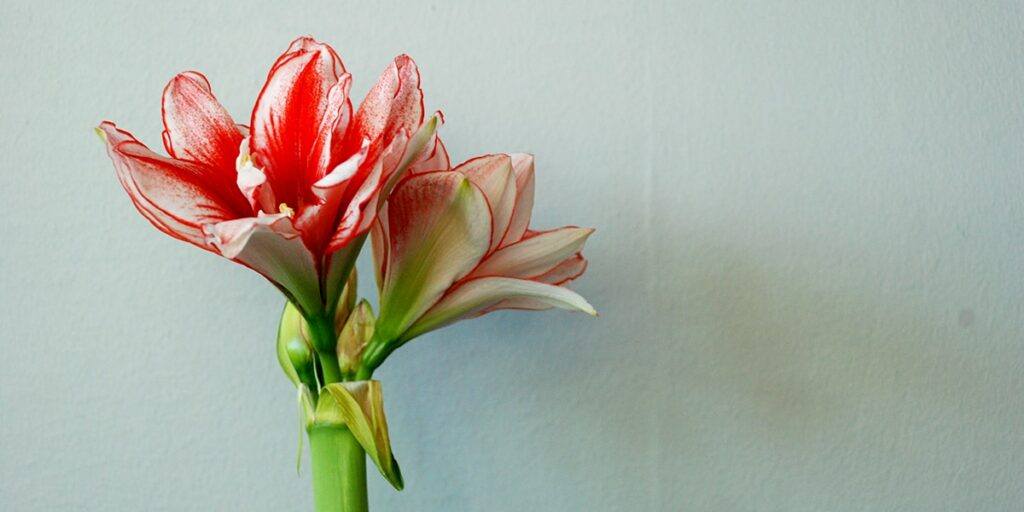
Amaryllis (Amaryllis belladonna)
Before discussing the aftercare of your amaryllis bulb, I want to give you a few tips on selecting bulbs. Amaryllis are often sold around the holidays as part of a kit containing a bulb, pot, and growing mix. They are ready to bloom, just add light and water. But before you purchase, open the box and inspect the bulb. Look for a bulb that has a bud tip showing. The taller the bud, the sooner it will bloom. If you only see leaves, your plant may not bloom. If it has both leaves and a flower bud, do not remove the leaves because these leaves will help the bulb make food after it blooms. The containers provided in the kit often do not have drainage holes. If this is the case, be very careful your bulb does not sit in soggy soil. My preference is to plant it in a container with ample drainage. Another option is to purchase loose bulbs. Look for the largest bulb for the variety. You will often have choices on size with the larger bulbs displaying more flowers.
Amaryllis Care after blooming: Your bulb may send up one to three flower stems. Once flowering is finished, prune the spent flower stems to about ½” from the bulb but do not remove healthy leaves. After your amaryllis blooms, it will need its leaves to make sugars for next year’s flowering show. Place your plant in bright light. Water to keep the soil lightly moist. Move it outdoors when night temperatures remain above 50°F. Repot your bulb in a slightly larger pot that drains well. Replant at the same depth it was in its original container. You can nestle it in your garden among your other plants. Fertilize once a month with a balanced fertilizer following label recommendations. Bring your plant indoors before the first frost and remove all the foliage 1-2 inches from the top of the bulb. Place it in a dry, dark area of your home and allow it to rest for ten to twelve weeks. At this time, it will go into dormancy. Do not water. After ten to twelve weeks, place it in bright light and water your plant. Once new leaves appear, you can place your plant on a regular watering schedule. Planted bulbs in zones 8b and higher can remain in your garden and will bloom naturally in the spring without any special care, but in colder zones, they must be brought indoors before the danger of frost.
Toxicity: All species of the Amaryllis family are toxic; all flowers, bulbs, and stems.
Insect pests: Pests include aphids and mealybugs.
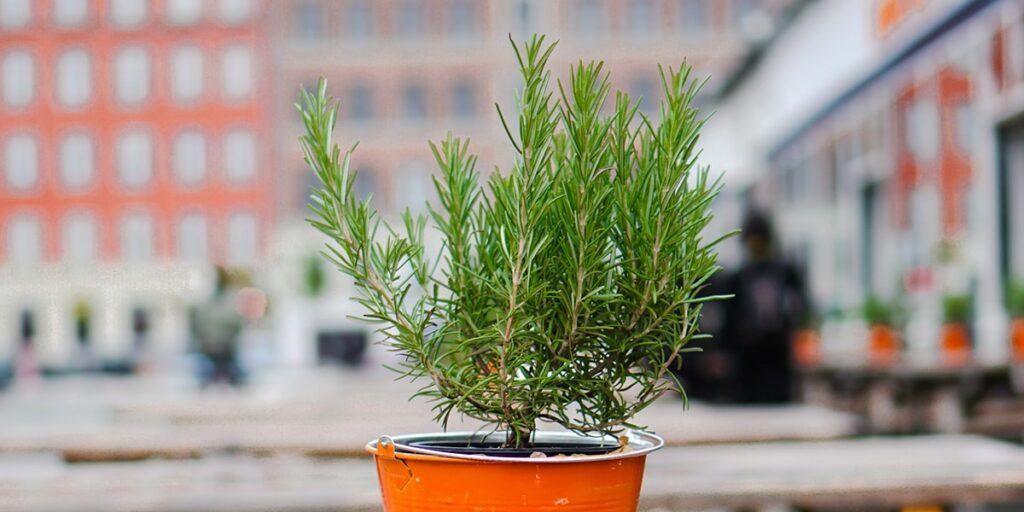
Rosemary Tree (Salvia rosmarinus)
Most garden centers sell rosemary Christmas trees as a festive ornamental addition to the holidays. These plants are functional as well as ornamental when used in culinary dishes. You can keep your rosemary going through the holiday season and beyond by following a few crucial steps to assure your plant will make it through the holiday season and into the growing season.
There is a good chance your newly purchased plant will be root-bound. Growers tend to grow these plants in the smallest possible containers for ease of shipping. Remove the rosemary from its pot and inspect the roots when you get your plant home. If you see only a small amount of soil for the roots to grow in, move to a bigger pot. Choose a pot that is approximate twice the size of its original container and be sure it has plenty of drainage holes. A terra-cotta pot is best because it will wick moisture through the sides of the pot and keep roots from staying too wet. Use a well-drained potting mix and water thoroughly. Water again when the top few inches of soil are dry to the touch. Rosemary plants are very moisture sensitive so be careful that it does not dry out. Unlike many other plants once rosemary dries out it will most likely not recover.
If your plant is not root-bound, you can wait until new growth begins in the spring to move it to a larger pot. Once new growth appears, you can begin pruning to the desired shape. It will eventually return to its natural habit of a shrub form if not pruned. You can move your plant outdoors anytime the temperatures are 40° F. and above but bring it back indoors in the evening if a frost is expected. Move it outdoors when temperatures remain above 40°F. gradually introducing it to the full summer sun. Rosemary plants can endure outdoor temperatures from hardiness zones 8 and up. The variety ‘Arp’ will tolerate zone 7 conditions.
Toxicity: Rosemary is an edible herb and is not toxic to neither humans nor pets.
Pests and diseases: Insect pests include aphids, thrips, whiteflies, mealybugs, and scale. Diseases include powdery and downy mildew, botrytis, and root rots.
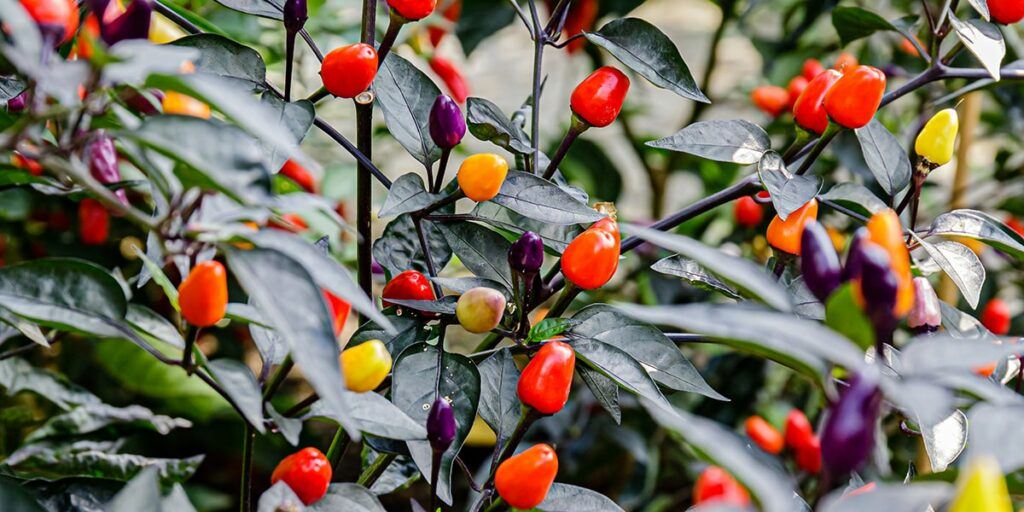
Christmas Peppers (Capsicum annuum)
Christmas Peppers are ornamental garden peppers or chili peppers grown during the holidays for their colorful fruits that somewhat resemble Christmas lights. The fruits change colors as they mature from green to yellow to orange to red or purple depending on the variety.
Christmas peppers were popular as far back as the 16th century as holiday ornamental plants along with poinsettias. Although not as popular as poinsettias are today, they provide a distinctive look for cheerful holiday displays. You can sometimes find them this time of year in garden centers, but they are easy to grow from seeds. Sow seeds toward the end of August in a well-draining potting mix. Give them a very bright light or full sun for the best growth. Pinch new growth to encourage branching.
If you grow them outdoors, be sure to bring them indoors before temperatures drop below the 50s. Use them for displays until after Christmas, then place them in a bright sunny window or under fluorescent lights to keep them going through the winter. They may stop growing and flowering if in low light conditions but will resume new growth when planted outdoors in the garden after the danger of frost in your area.
They make great unusual gifts during the holidays, especially if plants are hard to find in your area.
Toxicity: Caution: These peppers are edible, but the fruits are fiery hot. The juice from them can cause painful burning of the eyes and mouth just like any other hot pepper if fruits are handled, so be sure to wash your hands thoroughly if touching the fruits.
Pests: Inspect for whiteflies and aphids.

Cyclamen (Cyclamen persicum)
Cyclamens are easy-care houseplants that will bloom throughout the winter months. When purchasing, choose one with healthy-looking leaves and lots of buds that are just beginning to open. Cyclamens need cool temperatures below 70° F. to continue blooming. Warmer temperatures send the plant into dormancy while cooler temperatures signal new growth. Give it bright, indirect light in a cool room and water when the soil is slightly dry. Avoid getting water on the leaves and in the center of the tuber. Fertilize at ¼ teaspoon per gallon once every few weeks while in bloom. Remove spent flowers by removing the entire flower stalk where it attaches to the tuber.
Aftercare: When cyclamens stop blooming, leaves will turn yellow. The plant is very much alive but going dormant. Gradually reduce water, remove all dead foliage, and set outdoors in partial shade. Provide only enough water to keep the soil from completely drying out until new leaves emerge in the fall. When the new leaves emerge, repot in well-drained potting soil, bring indoors, and keep your plant cool throughout its blooming period. Repeat steps above for indoor care.
Toxicity: Cyclamen is toxic to pets and humans, especially when tubers and roots are eaten. A large amount of the plant would need to be ingested for serious symptoms to develop.
Pests: Cyclamen mites are the most serious problem.
Tips for long-lasting holiday plants:
- Before you head to the store, research your desired plants to make sure they’ll be safe for your needs. Depending on your family situation, plants that are toxic for humans or pets may be a hazard you need to avoid.
- Carefully examine the plants at the store to make sure you’re purchasing a healthy specimen.
- Determine if the pot or growing environment your plant came with is ideal for its growing needs, or for the supplier’s shipping and retail needs. Repot if needed. This is a great time to also double-check your plant to see if it has any unwanted pests or diseases.
- If your plant needs help with bugs or fungus, spray Earth’s Ally 3-in-1 Plant Spray to help kill and repel. Unlike many holiday plants, Earth’s Ally is safe for people and pets when used as directed.
- Follow the dormancy and reproduction cycles that are natural for your plant rather than try and force it to produce out-of-season.
We’d love to hear how Earth’s Ally is helping you care for your holiday houseplants! Share your experience and stay connected with the #EarthsAlly community on Facebook, Instagram and Twitter for access to our latest blog posts, giveaways and exclusive promotions.
